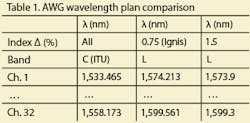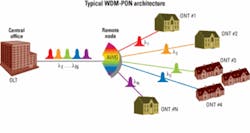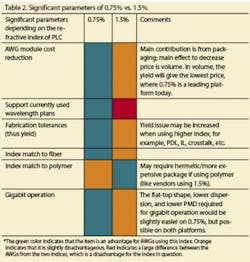Standardized wavelength plan crucial to WDM-PON
by Even Zimmer and Martin Boulanger
The future of FTTH technology is WDM, more specifically WDM-PON. WDM-PON is a point-to-point architecture that leverages all of the xPON (B/E/GPON)-associated advantages, particularly in terms of fiber management within the central office (CO). In a WDM-PON system, 32 wavelengths are multiplexed from the CO and travel to the remote terminal. At the terminal, the power splitter common to xPON implementations is replaced by an arrayed waveguide (AWG) filter that demultiplexes the 32 wavelengths to individual subscribers (see figure). Only WDM-PON provides the benefit of fewer cables into the CO while providing a virtual point-to-point system with a dedicated wavelength per household.
Although WDM-PON technology is in the early stages of development, many industry insiders and standards bodies already are studying how to deploy these systems economically while maximizing their flexibility and reliability. But to do so requires a wavelength plan for the AWGs.
A huge consideration in standardizing the wavelength plan involves choosing the refractive index of the planar lightwave circuit (PLC) process. Despite the claims of a few that moving to a 1.5% index will be more cost-effective, there are several key advantages to manufacturing PLC components using today’s common 0.75% refractive index.
First, though, systems manufacturers must ensure good communication with component vendors. The necessary specifications required in the components must be crystal clear to address important operational issues. In other words, solving issues at the system level will affect how components are manufactured.
For example, regulatory issues must be addressed before deploying WDM-PON within the U.S-specifically, the fact that video in the U.S. is distributed using overlay architectures. This architecture designates separate wavelengths for downstream IP, video, and upstream IP traffic.
Using the 1,550-nm wavelength-well separated from the 1,310- and 1,490-nm wavelengths-for video traffic enables the use of inexpensive lasers, but it also covers most of the C-band. For the current version of WDM-PON, this is a major showstopper, since WDM-PON systems use the C-band for IP traffic. The WDM-PON network propagation range is limited by the upstream propagation loss, and using the C-band enables the best maximum transmission distance. There is no technical reason for using overlay video because WDM-PON can supply enough bandwidth to package all the video signals onto the IP data stream. The continued use of an overlay strategy represents a major technical obstacle for U.S. operators and must be addressed within the next five years.Pricing is another major issue for the deployment of WDM-PON technology, as it requires an additional transceiver per subscriber at the optical line terminal (OLT), as well as two cyclic AWG filters instead of a single power splitter. The AWG filters work on two bands simultaneously: one dedicated to downstream traffic and the other to upstream traffic. Although the C- and L- bands have gained the most acceptance to date, other band combinations, such as the C- and S- bands or the C- and E- bands, also are being considered.
The main argument for using the C- and L- bands is their common use within telecom, specifically the fact that components and instruments are more readily available and therefore less expensive. Additionally, erbium-doped fiber amplifiers (EDFAs) work most efficiently on these bands. However, because the bands are physically closer together, better band filters are required to separate the wavelengths. That said, demonstrations have successfully achieved DWDM systems using both the C- and L- bands (Ignis Photonyx and LG-Nortel) and the C- and E- bands (Novera Optics).
The aforementioned issues aside, AWG component manufacturers have their own problems to solve if WDM-PON is to emerge in its most cost-effective form. The refractive index of the AWGs will play a major role in the ultimate standardization of the wavelength plan.
The lasers at the OLT and ONT are fed by the band-limited signal (BLS) that the AWGs filter. The lasers should oscillate on the wavelength the AWG transmits. The modulated light then moves through the first AWG and then through the second AWG. This occurs at different wavelengths for each of the 32 channels of the AWG, resulting in separate traffic to all 32 users.For each channel, the laser and filter spectrum must be well aligned to avoid attenuation. The wavelength plan dictates which wavelengths are used for each channel in both bands. Table 1 depicts the WDM-PON wavelength plan of the extreme channels (Channels 1 and 32). It is important to note that there is a difference of 200 to 300 pm in the 0.75% plan (as used in the LG-Nortel system) and the 1.5% plan. This would give rise to unacceptable penalties should they be mixed in the same network-i.e., an AWG with 0.75% at the remote node and an AWG with 1.5% at the CO or vice versa. Any waveguide process can adjust one band to the ITU, such as the C-band. However, the other bands (L, S, or E) then will be determined by the waveguide process.
For WDM-PON, the wavelength plan will dictate the required refractive index for AWG fabrication. Today, most component vendors involved in AWG fabrication work on the 0.75% index. However, a handful of vendors tout the 1.5% index as a more cost-effective approach. These vendors use athermalization techniques that feature polymer insertion at a higher index; thus, they can improve the performance of their athermal products by moving to the larger index.
Since there cannot be two standards for WDM-PON systems, the industry must decide which index level will best serve the application. Table 2 compares several key aspects that must be considered before migrating from the current, commonly used 0.75% refractive index to 1.5%.Because most vendors already use 0.75%, there is a strong likelihood that costs will be comparable as volumes ramp up, nullifying a move to 1.5%. Moreover, most AWG vendors already have the technology platforms for easy migration to 1 Gbit/sec, so it makes little sense to move to a higher index that would force vendors to redevelop their current processes and retune their designs.
And there is a high level of industry confidence in the 0.75% index for making AWGs; vendors achieve a good yield even at fewer chips per wafer. In fact, vendors get more good chips per wafer at 0.75% than at 1.5%. A move to 1.5% would result in issues that affect the optics, such as increased polarization-dependent loss and greater difficulty in achieving the lower dispersion required for higher bit rates.
The argument that using a 1.5% index would potentially reduce chip costs further erodes when one considers that 60% to 80% of the module cost is attributed to packaging. Packaging costs will not change at either index. However, at 0.75%, there is greater potential for higher volumes and high-volume packaging that will likely offset any cost savings gained by moving to 1.5%.
Consider the cost reductions in power splitters, which are also PLC chips, over the last 10 years. The majority of the cost of a power splitter module also is attributed to packaging. And yet the cost has been reduced from $40 or $50 per channel 10 years ago to about $10 per channel today. Every cost reduction in power splitters has resulted purely from volume manufacturing; the index of these chips has never changed in order to put more chips on a wafer. The cost of AWGs for WDM-PON systems should follow a similar pattern.
In short, the distance on the refractive index between 0.75% and 1.5% is too far to make compensation by AWG chip design possible. With the majority of PLC manufacturers already successfully using the 0.75% index, it only makes sense to continue making AWGs for WDM-PON at this lower index. Standardizing on 0.75% will enable volume production and packaging of AWGs, which will eventually play a role in reducing overall capital expenditures (capex) in future systems.
Volume component production will help further offset the capex costs of installing the optical equipment for a WDM-PON system, compared to the costs of xPON. And advances in optical integration could reduce capex even more.
The million-dollar question is still whether the futureproofing and additional bandwidth achieved with WDM-PON systems will actually be worth the capex costs. An additional argument, however, is that the cost per megabit supplied is lower in WDM-PON than in xPON-and that, after all, is what the end user is purchasing. With bandwidth demand increasing faster than advances in the technologies designed to support it, researchers and designers must find the means to make WDM-PON a viable technology for system manufacturers and operators.
Even though significant numbers of systems may not roll out for another three to five years, the industry is expecting WDM-PON to emerge in one form or another. The world’s large network operators see it as inevitable and want the wavelength plan standardized.
Component vendors should have the opportunity to present their case to the standards bodies developing the wavelength plan for WDM-PON. System vendors and operators should be aware that the 0.75% index is used by a vast majority of their component suppliers, making components more available and reliable. Moving to a 1.5% index could raise both cost issues and supply problems. With good communication, component vendors are in the best position to help their customers make informed decisions about the wavelength plan for WDM-PON.Even Zimmer is the chief technology officer at Ignis Photonyx AS (www.ignis.com), headquartered in Lysaker, Norway. Martin Boulanger is a senior designer at Ignis Photonyx’s wafer fab in Copenhagen, Denmark.



